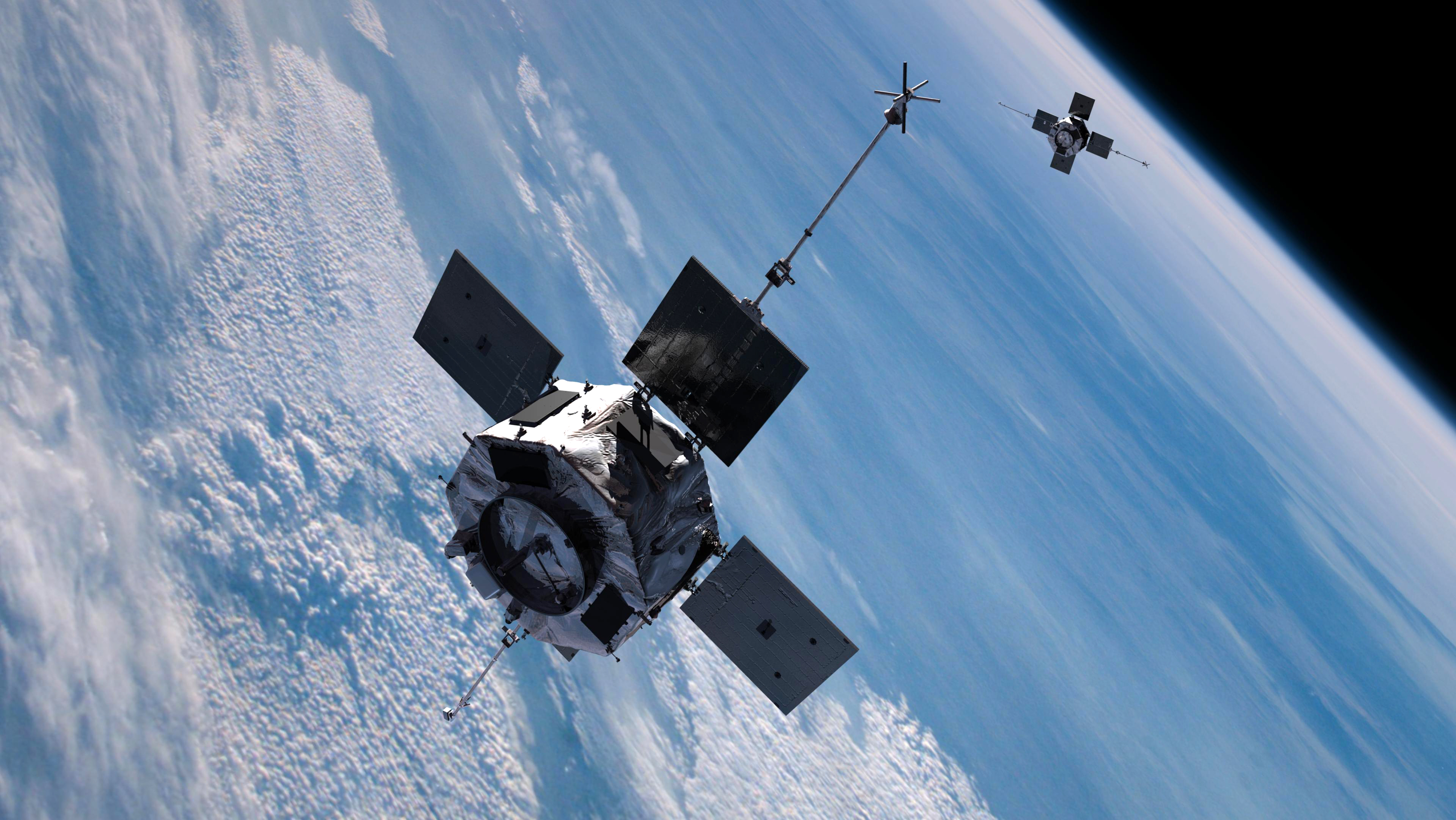October 17, 2019
Mission Accomplished: Van Allen Probes Conlude Seven Years of Discovery
Originally slated for a two-year mission, the second of the twin Van Allen Probes spacecraft will be retired just prior to running out of propellant, more than seven years after launch. On October 18, 2019, at about 12:30pm EDT, spacecraft A of the Van Allen Probes mission will be shut down by operators at the Johns Hopkins University Applied Physics Lab in Laurel, Maryland. The command – the 4,781st sent to spacecraft A – is of the same type sent four months previously that terminated operations for spacecraft B, the second spacecraft of the mission.
In February, the spacecraft were placed in a lower orbit that will eventually decay, letting the twin Van Allen Probes re-enter and burn up in Earth's atmosphere.
These two spacecraft – designed, built, and operated for NASA by Johns Hopkins APL – flew through the rings of charged particles trapped by Earth's magnetic field known as the Van Allen Belts to understand how particles were gained and lost by the belts. The spacecraft made major discoveries that revolutionized how we understand our near-Earth environment.
"The Van Allen Probes team did the impossible," said Jason Kalirai, APL's civil space mission area executive. "They designed and built a resilient mission to fly in a region of space that other missions deliberately avoid. The resulting scientific data have transformed our understanding of the radiation belts, and will benefit future NASA space science missions and human exploration beyond low Earth orbit."
"The Van Allen Probes rewrote the textbook on radiation belt physics," said Sasha Ukhorskiy, Van Allen Probes project scientist at APL. "The Probes used uniquely capable instruments to unveil radiation belt features that were all but invisible to previous sensors, and discover many new physical mechanisms of radiation belt acceleration and loss."
With instruments measuring electromagnetic fields and charged particles, the Van Allen Probes explored the invisible phenomena shepherding particles in and around the belts. It made discoveries about the architecture of the belts and the forces shaping them. Just as ocean storms on Earth can create giant waves, space weather, caused by the Sun, can create plasma waves, where seas of particles are tossed by electromagnetic fields. The Van Allen Probes, launched on August 30, 2012, pioneered new explorations into the dynamics of these waves and their effects on our near-Earth environment.
"Van Allen Probe observations have been the subject of over 600 publications to date in refereed journals, and over 55 PhD theses have used Van Allen Probe observations," said David Sibeck, Van Allen Probes mission scientist at NASA's Goddard Space Flight Center in Greenbelt, Maryland.
In celebration of the mission's success, here are ten select discoveries, listed in chronological order, made by the Van Allen Probes.
- The Van Allen belts were first discovered in 1958 and for decades scientists thought there were only two concentric belts. But days after the Van Allen Probes launched, scientists discovered that during times of intense solar activity, a third belt can form.
- The belts, which are composed of charged particles and electromagnetic fields, can be energized by different types of plasma waves. One type, called electrostatic double layers, appear as short blips of enhanced electric field. During one observing period, Probe B saw 7,000 such blips repeatedly pass over the spacecraft in a single minute. These individually small events added up to one million volts over six minutes, capable of accelerating electrons up toward the relativistic energies commonly seen in radiation belt particles.
- During big space weather storms, which are ultimately caused by activity on the Sun, ions — electrically charged atoms or molecules — can be pushed deep into Earth's magnetosphere in a series of impulsive events. These particles carry electromagnetic currents that circle around the planet and can dramatically distort Earth's magnetic field.
- Across space, fluctuating electric and magnetic fields can create what are known as plasma waves. These waves intensify during space weather storms and can accelerate particles to relativistic speeds. The Van Allen Probes found that one type of plasma wave known as hiss can contribute greatly to the loss of electrons from the belts.
- The Van Allen belts are composed of electrons and ions with a range of energies. In 2015, research from the Van Allen Probes found that, unlike the outer belt, there were no electrons with energies greater than a million electron volts in the inner belt.
- Plasma waves known as whistler chorus waves are also common in our near-Earth environment. These waves can travel parallel or at an angle to the local magnetic field. The Van Allen Probes demonstrated the two types of waves cannot be present simultaneously, resulting in greater radiation belt particle scattering in certain areas.
- Very low frequency chorus waves, another variety of plasma waves, can pump up the energy of electrons to millions of electron volts. During storm conditions, the Van Allen Probes found these waves can hugely increase the energy of particles in the belts in just a few hours.
- Scientists often use computer simulation models to understand the physics behind certain phenomena. A model simulating particles in the Van Allen belts helped scientists understand how particles can be lost, replenished and trapped by the Earth's magnetic field.
- The Van Allen Probes observed several cases of extremely energetic ions speeding toward Earth. Research found that these ions' acceleration was connected to their electric charge and not to their mass.
- The Sun emits faster and slower gusts of charged particles called the solar wind. Since the Sun rotates, these gusts — the fast wind — reach Earth periodically. Changes in these gusts cause the extent of region of cold ionized gas around Earth — the plasmasphere — to shrink. Data from the Van Allen Probes showed that such changes in the plasmasphere fluctuated at the same rate as the solar rotation — every 27 days.
"This mission spent seven years in the radiation belts, and broke all the records for a spacecraft to tolerate and operate in that hazardous region, all with no interruptions," said Nelofar Mosavi of APL, the Van Allen Probes project manager. "This mission was about resiliency against the harshest space environment. We proudly accomplished these operations and scientific successes with collaboration and hard work from the engineering, science and instrument teams including our partners at NASA, the University of New Hampshire, University of Iowa, University of Minnesota, New Jersey Institute of Technology, and the Aerospace Corporation."
- Mara Johnson-Groh, NASA's Goddard Space Flight Center, Greenbelt, Md.


